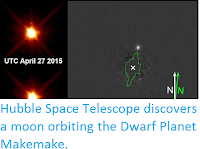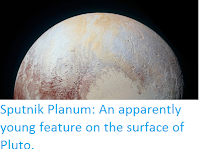The Dwarf Planet Pluto reached opposition (directly on the opposite side of the Earth as the Sun) at 2.17 am GMT on Thursday 16 July 2020. This means that it was at its
closest to the Earth this year, about 33.07 AU (33.07 times the
average distance between the Earth and the Sun, or about 4 947 000 000
km), and completely illuminated by the Sun. While it is not obvious to
the naked eye observer, the planets have phases just like those of the
Moon; being further from the Sun than the Earth, Pluto is 'full' when
directly opposite the Sun, although with an apparent magnitude of only 14.9 it will take a reasonably good telescope to see Pluto at all, and it will only be visible as a star-like point to those that can see it.
The orbit and position of Pluto and the planets of the Solar System on 14 July 2020. In the Sky.
Pluto was discovered in 1930 by Clyde Tombaugh, a young astronomer working at the Lowell Observatory
in Arizona; its existence had been predicted as early as 1909, due to
anomalies in the orbit of Neptune. At the time it was assumed that Pluto
was a planet of some size, capable of disturbing the orbit of Neptune.
Pluto spends part of its 248 earth year orbit inside the orbit of
Neptune; this is not the same on every orbit, but alternates between a
20 and a 14 year stay.
The Dwarf Planet Pluto imaged by the New Horizons space probe in July 2015. NASA/JPL/Southwest Research Institute.
Pluto was downgraded from a planet to a dwarf planet by the International Astronomical Union
in 2006, following the discovery of several similar small bodies in the
Kuiper Belt beyond the orbit of Neptune. The term 'Dwarf Planet' is now
used to designate objects large enough to form a roughly spherical
shape under their own gravity, but no so massive as to have cleared the
area around their orbit of all other objects. Pluto, Haumea, Makemake,
and Eris were placed in this category, as was Ceres in the asteroid
belt. Ceres had also been classified as a planet at the time of its
discovery in 1801, as were a number of other asteroids until the
mid-nineteenth century, when it became clear that asteroids were too
abundant to be classed as planets.
The comparative sizes of Pluto, its largest moon, Charon, and the continental United States of America. Calvin Hamilton/Cornell University.
Pluto has an 247.7 year orbital period and an eccentric orbit
tilted at an angle of 17.1° to the plane of the Solar System, which
takes it from 29.6 AU from the Sun (i.e. 2960% of the the average
distance at
which the Earth orbits the Sun) to 49.4 AU from the Sun (i.e. 4940% of
the
average distance at which the Earth orbits the Sun). As a body which spends most of its time outside the orbit of the planet Neptune it is classed as a Trans-Neptunian Object, even though it does come inside the orbit of Neptune for part of its orbital period.
See also...
Follow Sciency Thoughts on Facebook.









